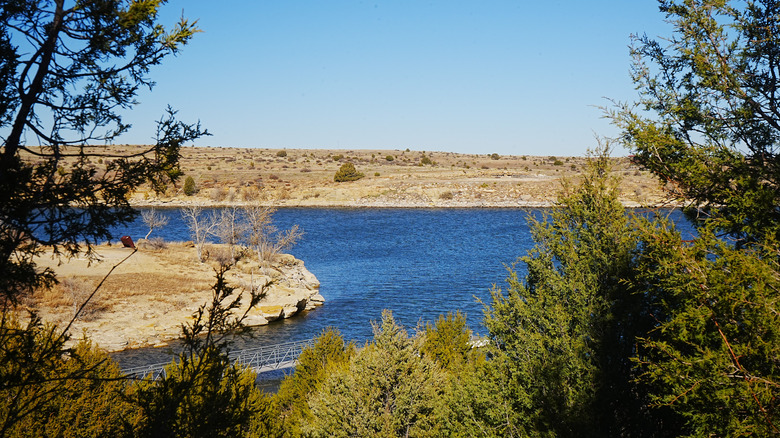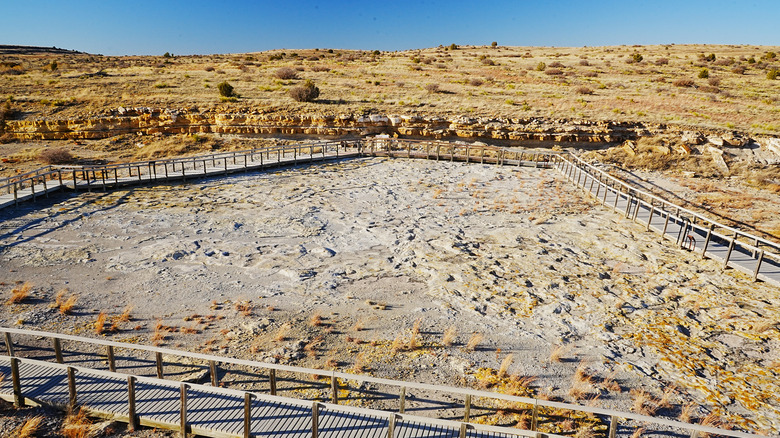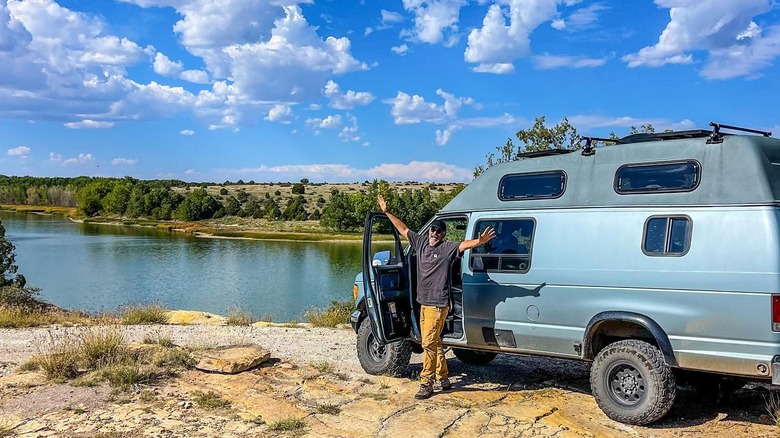New Mexico's First Dark Sky State Park Is A Lakefront Charmer With Unique Dinosaur Tracks And Recreation
Few experiences evoke the sense of awe and peaceful satisfaction as staring into a vast expanse of ultra-dark night sky illuminated by an uncountable number of stars. From north to south, New Mexico wows with pristine stargazing that makes even the most jaded visitors marvel at their place in the universe. But, only Clayton Lake State Park earns the distinction of being New Mexico's first certified International Dark Sky site — a prestigious title it has held for 15 years and counting.
Tucked away in the far northeastern corner of New Mexico, about a 2.5-hour drive from Amarillo (Texas' largest Pandandle city), Clayton Lake State Park is undeniably remote. Miles upon miles of flat country and seemingly endless roads will make you question whether you'll ever reach the park entrance, but the reward is worth the journey. Here, New Mexico's layered shale and sandstone outcroppings reach the Great Plains, while rolling clouds and stars reflect upon the serene surface of the artificial Clayton Lake.
Situated at an elevation of over 5,000 feet, the Star Point Observatory offers the chance to gaze at celestial bodies through a 14-inch Meade telescope. However, thanks to the low light pollution, you can see plenty of constellations and the Milky Way with the naked eye. Be sure to ask the staff at the visitor center about "Star Parties" and other events, or check out the park's calendar. For the darkest night skies, don't forget to plan your trip during the new moon phase.
Walk in the footsteps of dinosaurs at Clayton Lake State Park
Although the dark night skies are utterly jaw-dropping and on par with any of the best national parks in America for skygazing, Clayton Lake State Park's dinosaur footprints are one of its main draws. As some of the best preserved in the U.S., you can discover over 500 tracks left by dinosaurs over 100 million years ago as they trekked across an ancient ocean strait. You can even spot marks where dinosaurs slipped in the mud and used their tails to right themselves.
Visitors can see the tracks up close by taking a 1-mile, out-and-back hike to a network of wooden boardwalks extending over the dinosaur trackway. Here, you'll find interpretive information about the creatures that lived here and learn to distinguish between carnivorous and herbivorous dinosaur tracks. Keep in mind that the boardwalk is unshaded, so you'll want to bring sunscreen, a hat, and extra water even though the route is short.
The park attracts a range of visitors, including road trippers, dinosaur enthusiasts, and lucky travelers who happen to stumble upon something amazing. One visitor on Tripadvisor shares, "The site does a good job of taking you back in time to imagine the creatures that passed through here on their wanderings."
Discover lakeside camping and other recreational opportunities at Clayton Lake State Park
Although the rocky shoreline doesn't offer sandy beaches, Clayton Lake State Park is an ideal destination for fishing, camping, boating, kayaking, and birding. In comparison to the crowded Elephant Butte Lake State Park, aka New Mexico's "Diamond in the Desert," Clayton Lake only receives 65,000 visitors annually. Even on weekends, the park offers a peaceful setting for exploring the volcanic rock formations and spending the afternoon on the water. Visitors are allowed to launch motorized and non-motorized crafts from the boat launch, but the park doesn't offer rentals.
The best way to experience the park is by spending the night at one of 26 campsites spread around the lake, including nine RV-friendly sites with water and electricity. Nestled in the rocky buttes or thickets of shrubs, many of the sites offer lake views and are well spaced out. Alternatively, visitors can stay at the highly rated Coyote Keeth's RV Park or choose from typical roadside hotels, like the Best Western or Super 8, only 12 miles away in Clayton. The tiny town is also your go-to meal stop, with dining options including Sí, Señor Tacos and breakfast staples at Mock's Mill.
If you're a fishing enthusiast, consider visiting between March and October when the 170-acre lake is open to anglers. Channel catfish, largemouth bass, and rainbow trout swim in the waters, and the largest walleye caught in New Mexico was reeled in at Clayton Lake.


